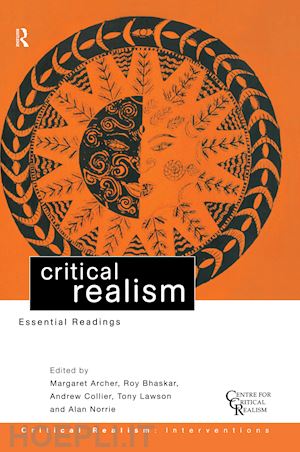Part 1 Transcendental Realism and Science; Chapter 1 Introduction, Roy Bhaskar, Tony Lawson; Chapter 2 Philosophy and Scientific Realism Source: A Realist Theory of Science, London: Verso, 1997, chap. 1, pp. 21–62., Roy Bhaskar; Chapter 3 The Logic of Scientific Discovery Source: A Realist Theory of Science, London: Verso, 1997, chap. 3, sections 3.1–3.3, pp. 143–84, and sections 3.5 and 3.6, pp. 199–228., Roy Bhaskar; Chapter 4 Conceptual and Natural Necessity Source: Causal Powers: A Theory of Natural Necessity, Oxford: Basil Blackwell, 1975, chap. 1, Sections II-VI, pp. 8–26., R. Harré, E.H. Madden; Chapter 5 Abstraction Source: Radical Philosophy, 1981, Summer, pp. 6–15., Andrew Sayer; Chapter 6 Economic Science Without Experimentation Source: Economics and Reality, London: Routledge, 1997, chaps 15 and 16, pp. 199–226 and 227–237., Tony Lawson; Chapter 6a Abstraction; Part 2 Critical Naturalism and Social Science; Chapter 7 Introduction, Margaret Archer; Chapter 8 Societies Source: The Possibility of Naturalism, chap. 2, Harvester Wheatsheaf, Hemel Hempstead, 1989 (referred to as PON in this chapter)., Roy Bhaskar; Chapter 9 Stratified Explanation and Marx's Conception of History Source: Scientific Realism and Socialist Thought, chap. 2, pp. 43–72., Andrew Collier; Chapter 10 Realism and Social Science Source: New Philosophies of Social Science, chap. 3, pp. 44–60 (referred to in the text as NPSS)., William Outhwaite; Chapter 11 Realism and Social Science Source: Radical Philosophy, 27, 1981, pp. 13–21., Ted Benton; Chapter 12 A Realist Social Science Source: A History and Philosophy of the Social Sciences, chap. 13, pp. 266–293 (referred to in the text as AHPSS)., Peter Manicas; Chapter 13 Four Concepts Of Social Structure Source: Journal for the Theory of Social Behaviour, 19, 2, 1989, pp. 195–211., Douglas V Porpora; Chapter 14 Realism and Morphogenesis Source: Realist Social Theory: The Morphogenetic Approach, chap. 5, pp. 135–161 (referred to in the text as RST)., Margaret Archer; Part 3 The Theory of Explanator Critiques; Chapter 15 Introduction, Roy Bhaskar, Andrew Collier; Chapter 16 Reason as Dialectic Source: Radical Philosophy, 15, 1976, pp. 2–7., Roy Edgley; Chapter 17 Facts and Values Source: Scientific Realism and Human Emancipation, London: Verso, 1986, chap. 2, sections 5, 6 and 7, pp. 169–211, Roy Bhaskar; Chapter 17a Reason and the Dialectic of Human Emancipation; Chapter 17b Depth, Rationality and Change; Chapter 18 Explanation and Emancipation Source: Critical Realism, London: Verso, 1994, chap. 6, pp. 169–204., Andrew Collier; Chapter 19 Neutrality in the Social Sciences Source: Journal for the Theory of Social Behaviour, 27, 2/3, 1997, pp. 213–41., Hugh Lacey; Chapter 20 Addressing the Cultural System Source: Culture and Agency, Cambridge: Cambridge University Press, 1988, chap. 5, pp. 103–42., Margaret Archer; Chapter 21 The Praxiology of Legal JudgementSource’. Crime, Reason and History, London: Butterworths, 1993, pp. 221–60, Alan Nome; Part 4 Dialectic and Dialectical Critical Realism; Chapter 22 Introduction, Roy Bhaskar, Alan Norrie; Chapter 23 Critical Realism and DialecticSource: Dialectic: The Pulse of Freedom, London: Verso, 1993, chapters 1.5–1.7, 2.1, 2.2 and 2.7., Roy Bhaskar; Chapter 23a Dialectic; Chapter 24 Dialectical Critical Realism and EthicsSource: Dialectic: The Pulse of Freedom, London: Verso, 1993, chapters 3.1, 3.2, 3.7 and 3.10., Roy Bhaskar; Chapter 25 The Power of Negative ThinkingSource: Radical Philosophy, 69, January-February 1995, pp. 36–9., Andrew Collier; Chapter 26 Realism and Formalism in Ethics, Andrew Collier; Chapter 27 The Limits of JusticeSource: Modern Law Review, 59, 1996, pp. 540–56., Alan Norrie; Chapter 28 Between Structure and Difference Source: The Emergence of Law Through Economy, Politics and Culture, 1997, vol. 1, chap. 2, Ofiati: International Institute for the Sociology of Law., Alan Norrie;











